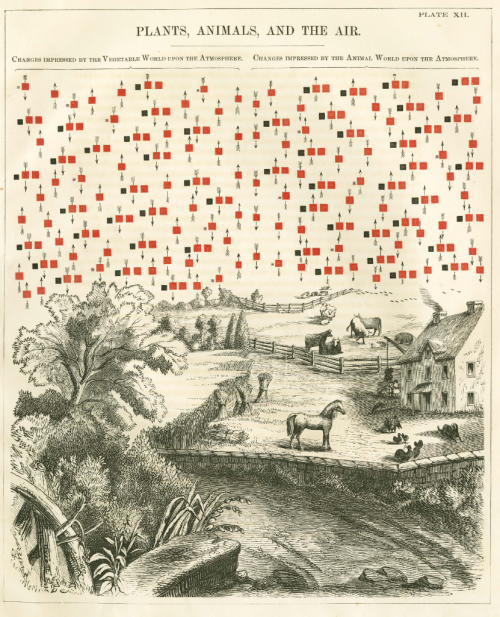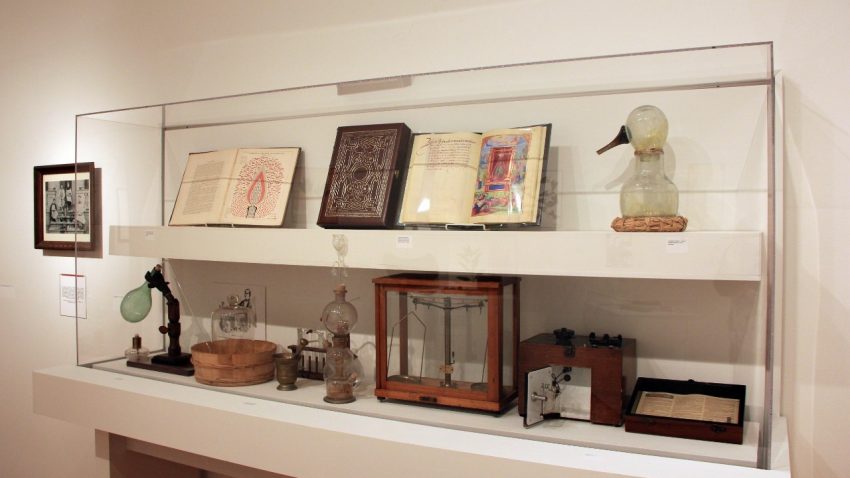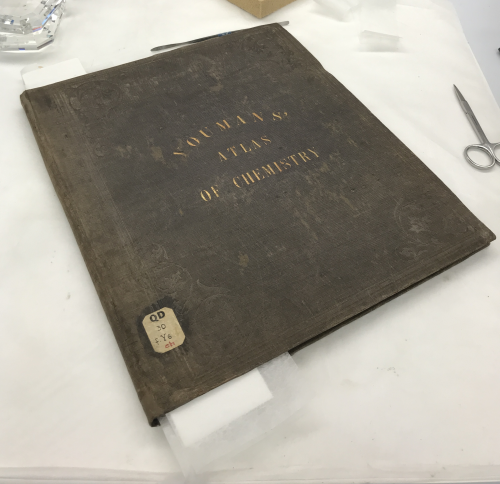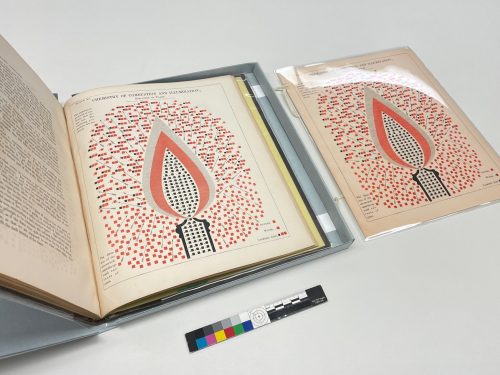Edward Livingston Youmans’ The Chemical Atlas was recently returned to its home in the Oesper Collections in the History of Chemistry library after receiving conservation treatment from UC Libraries’ Preservation Lab. Youmans’ famous book features eye-catching illustrated and hand-colored plates that frequently motivate myself and others to display the item and engage visitors of the Oesper Collections with stunning visual depictions of the unseen world of chemical processes.
Edward Youmans was a renowned science communicator and popularizer in the 19th century United States. In the 1850’s, a reviewer called his Chemical Atlas “without exception, the best popular work in the English language” (Miles, 1964). When he was a young teen, he was afflicted by a disease of the eyes which grew more severe with time, leaving him nearly blind and suffering from frequent eye inflammation between the ages of 13 and 35. During these years, Youmans was unable to read, and learned as much as he could through the second-hand teaching of his sister, Eliza Youmans. His second-hand learning caused him to imagine and visualize chemistry concepts. As he overcame his misconceptions and worked to make his understanding more definite, he wanted to share his scheme for picturing atoms and their combinations. This led to him creating chemical charts which visually depicted atoms of different elements, binary compounds, and more as well as an accompanying book, Classbook of Chemisty. The Classbook of Chemistry was a huge success. “Brief, clear, and devoid of technicalities, it has an astounding and continuous sale; it was revised and sold more than 144,000 copies in its three editions. This was truly a remarkable record and would be envied even in these days of widespread chemical instruction” (Oesper, 1957).
In her biographical sketch of her brother published in Popular Science Monthly in 1887, Eliza notes that the illustrations and concepts found in the Chemical Atlas were an extension of Youmans’ chart method of teaching chemistry. The text was designed for students who had no experience or knowledge of chemistry and took its aim at explaining the chemistry of “familiar objects” as explained in the work’s full title – Chemical atlas ; or, The chemistry of familiar objects; exhibiting the general principles of the science in a series of beautifully colored diagrams, and accompanied by explanatory essays, embracing the latest views of the subjects illustrated. Designed for the use of students and pupils in all schools where chemistry is taught. Towards this goal, he illustrated and described the processes of fermentation, illustrated using grape sugar and its breakdown into carbonic acid, hydrogen, and butyric acid, the process of combustion, the composition of salts, and the carbon dioxide and oxygen cycle. The illustration of the carbon dioxide and oxygen cycle was so interesting that Ralph Oesper, namesake and endower of the Oesper Collections, wrote about it in 1957 in the 34th volume of the Journal of Chemical Education. See images of these colored plates below:

Plate X. Vinous, Lactic and Butyric Fermentations. Youmans’ Chemical Atlas. 1857.

Plate XI. Chemistry of Combustion and Illumination; Structure of Flame. Youmans’ Chemical Atlas. 1857.

Plate XII. Plants, Animals, and the Air. Youmans’ Chemical Atlas. 1857.
Remarkably, this Chemical Atlas was published about 14 years before Dmitri Mendeleev published the first version of the periodic table we know and recognize today. In the introduction to the Atlas, Youmans discusses how important it is to illustrate chemistry. “The superiority of the eye over all other senses, as a means of education, is undeniable… Whenever the object to be contemplated cannot itself be seen, and consists of such fixed elements or qualities as are capable of being represented or delineated to the eye, pictorial illustrations become indispensable” (Youmans, 1856). The Chemical Atlas was an innovative publication in the use of color to convey quantitative information. It is emblematic of his drive to popularize a scientific understanding of the world and disseminate scientific knowledge in a way more and more people could understand. In 1872, Youmans founded Popular Science Monthly and served as the editor until he passed in 1887. Popular Science Monthly was later merged into the Scientific American.
Thanks to the beautiful illustrations of familiar chemical processes like combustion, this item is often shown to visitors of the Oesper Collections and in other displays both here at UC and in other libraries such as the New York Public Library and the Library of Congress. At the University of Cincinnati, this item was included in the 200 Years of Curation Exhibit in the DAAP Reed Gallery which celebrated the bicentennial of UC in 2019.

The Oesper Collections’ display case at the 200 Years of Curation exhibit. Youmans’ Chemical Atlas can be seen in the top left.
Due to its frequent use, the book was taken to the Preservation Lab for conservation treatment. They found that the binding was in poor condition, with the cloth spine detaching (see picture below).

The Chemical Atlas before conservation treatment.
The excellent conservators at the Preservation Lab cleaned the book and relined the text block. They then resewed the textblock and relined the spine before lining the spine and text block with toned tissue and repairing the hinges. They encased the book in a polyester jacket and created new housing for it with a corrugated clamshell box. They also created a beautiful surrogate of the “Chemistry of Combustion and Illumination; Structure of Flame” plate to use in displays and exhibits.

The Chemical Atlas after conservation treatment.

The Chemical Atlas, inside its new housing, next to the surrogate of Plate XI. Chemistry of Combustion and Illumination; Structure of Flame.
The full text of the Chemical Atlas can be found on HathiTrust, but nothing can replace viewing the popping vibrant colors in person. Come see this title and other fascinating gems from the history of chemistry at the Oesper Collections by contacting Mark.Chalmers@uc.edu or Ted.Baldwin@uc.edu to set up an appointment.
References:
Miles, Wyndham D. “Edward Livingston Youmans-America’s Great Science Popularizer of a Century Ago.” School Science and Mathematics, vol. 64, no. 6, June 1964, p. 491
Oesper, Ralph E. “‘Chemical Atlas’ by Edward L. Youmans.” Journal of Chemical Education, vol. 34, no. 8, Aug. 1957, p. 408.
Youmins, Edward L. “Chemical Atlas”, Appleton & co. New York. 1856.
Youmins, Eliza. “Sketch of Edward L. Youmans” The Popular Science Monthly. Popular Science Pub. Co., March 1887, p. 688.
